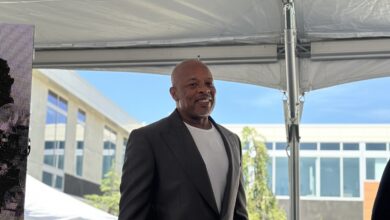Special Report: Aerospace – Los Angeles Business Journal

The year that just ended defied expectations in the aerospace industry.
That is the view of Michelle Iturralde, a market executive for Bank of America and head of its aerospace division in Los Angeles.
The aerospace industry has long been a component of L.A.’s economy and is likely to remain so.
It encompasses the big players like Aerojet Rocketdyne Holdings Inc., Northrop Grumman Corp. and Boeing Co., down to the small machine shops that do work for the big companies. It also has startups and newer companies like Skyryse and Rocket Lab USA Inc. in Long Beach and Space Exploration Technologies Corp., better known as SpaceX, in Hawthorne.
Iturralde said she has seen greater efficiencies in the aerospace industry, as well as higher margins that offset wage inflation last year.
Iturralde also noted noticeable improvements in the supply chain, which was a big challenge for the industry at the onset of the global pandemic..
“That dynamic has changed; the supply chain and production is back and there is huge demand for the (original equipment manufacturers) and the aerospace industry in general,” she said. “It is growing.”
The total value of the global aerospace and defense industry is forecast to reach $1 trillion in 2026, Iturralde said, with the overall space economy reaching $1.1 trillion by 2030.
That compares to the global space economy doing $469 billion in business in 2021, she said.
Iturralde attributed the increase to government commitment to research and development.
“The government and military play an important role in R&D, and over the past decade or so have opened up the door to privatization of small to medium-sized companies to bring technology and innovation from the private sector to help solve for their commitment to continue to support homeland security and continue to support the largest military on the planet,” she said.
Growth in the market
But it is the emergence of private companies such as Rocket Lab USA Inc. and SpaceX that has been a huge growth benefit to the labor force in Southern California, and Los Angeles in particular.
Iturralde estimated that 50% of the emerging space companies that are raising noteworthy funding rounds “are in our backyard here in Southern California; in Pasadena, Los Angeles, Culver City, Playa Vista.
“This is another point that shows the growth and opportunity for Los Angeles to have a big impact in global space exploration,” she said.
NASA had for decades been in control of all of the innovation and research in the space industry and in launching and infrastructure and satellite imagery, Iturralde continued.
“Over the last decade or so, we have had the opportunity to privatize the capabilities in space, such as launch services, infrastructure and satellites,” she added. “Having that opportunity for the privatization in the sector has allowed the private sector to raise funds to support the ideas and innovation brought to the U.S. government and governments around the world to continue to improve how we can grow this sector.”
Key to that growth is the presence of qualified employees to work at the aerospace companies.
Iturralde called the labor force in Southern California “like nowhere else in the world” given the amount of research and the number of universities focused on science and technology.
“That is why Los Angeles continues to attract companies to be headquartered in (the city),” she said. “Because of the talent, the human capital, the resources that we are able to commit to here locally.”
Aerojet Rocketdyne’s Engines Still Powering On
The biggest news for Aerojet Rocketdyne in the last six months happened at the end of July.
That was when L3 Harris Technologies Inc. announced it had closed on its acquisition of the storied company.

Still based in El Segundo, with significant operations in Chatsworth in the San Fernando Valley, Aerojet Rocketdyne has been fully absorbed by its new owner.
The acquisition diversifies the L3Harris portfolio, adding considerable long-cycle backlog and broad expertise that enables opportunities in missile defense systems, hypersonics and advanced rocket engines, among other areas.
The firm will be known as Aerojet Rocketdyne, an L3Harris Technologies company.
Christopher E. Kubasik, chief executive of L3Harris, said that he was thrilled to welcome the 5,000 employees of Aerojet to the L3Harris team.
“With national security at the forefront, we’re combining our resources and expertise with Aerojet Rocketdyne’s propulsion and energetics capabilities to ensure that the Department of Defense and civil space customers can address critical mission needs globally,” Kubasik said in a statement.
The company also announced that Ross Niebergall will serve as president of the Aerojet segment at L3Harris.
“Our customers demand a competitive environment that produces innovative, agile solutions,” Niebergall said. “We will expand on the strong Aerojet Rocketdyne heritage to enhance production and deliver on those expectations.”
That heritage includes making engines for the Saturn V rocket that took man to the moon in late 1960s to early 1970s, as well as the main engines for the Space Shuttle.
In fact, some shuttle main engines, also known as the RS-25, are being repurposed in Chatsworth to be used aboard Artemis II, the NASA mission that will take humans around the moon in the next year or two. The Valley factory is also producing new RS-25 engines for subsequent Artemis missions to the moon.
During each launch of the Space Launch System, NASA’s heavy lift rocket, four RS-25 engines will generate more than 2 million pounds of combined thrust as they burn for just over eight minutes and consume more than 90,000 gallons of propellant, Aerojet said. With its use of liquid hydrogen and liquid oxygen, the only exhaust coming from the RS-25 engines is clean, superheated water vapor (or steam) with zero carbon emissions.
RS-25 program director Doug Bradley said that it was a privilege to be part of the Aerojet team designing, manufacturing, assembling and testing the rocket engines.
“Watching the first SLS launch during the Artemis I mission (in November 2022), with the help of our powerful RS-25 engines, took my breath away,” Bradley said. “We are truly at the dawn of a new era of human deep-space exploration.”
The company also contributed the main engine and auxiliary engines for the Orion service module used on Artemis, as well as thrusters used on the crew module.
The Artemis I mission was a national effort with contributions from Aerojet Rocketdyne sites located in Chatsworth; Sacramento; Redmond, Washington; West Palm Beach, Florida; Stennis, Mississippi; Carlstadt, New Jersey; Huntsville, Alabama; Orange, Virginia; and Camden, Arkansas.
In late August 2021, the company opened a $59 million expansion that added 30,000 square feet of manufacturing space to the facility in Chatsworth. The cost also included new equipment.
Musk’s SpaceX Sports Valuation of $180 Billion
When it comes to aerospace companies in Los Angeles County, there is none more famous than Space Exploration Technologies Corp.
Better known as SpaceX, the Hawthorne-based company founded by eccentric billionaire Elon Musk has launched 290 rockets and retrieved 253 of them. The firm has also carried out a total of 225 reflights with the first stage of its Falcon spacecraft.
Attempts to reach a representative of SpaceX were not successful.
But the company’s website includes a long list of recent launches the company has carried out in the past couple of months.

These include launches on Dec. 2, 7 and 8 for the Starlink system, a constellation of satellites built by SpaceX to provide internet service in 65 countries. A Starlink launch scheduled for Dec. 13 was scrapped due to weather. It launched on Dec. 18.
On Dec. 1, SpaceX launched the Korea 425 mission to low-Earth orbit from Vandenberg Space Force Base. There was a total of 25 satellites on board this mission.
And on Nov. 20, 22 and 27, three Starlink missions launched from Vandenberg or Cape Canaveral Space Force Station in Florida.
All that came after the Nov. 18 launch of the second test flight of the Starship rocket, the largest one ever built, from the company’s Starbase in Texas. The heavy boosters on the rocket broke up – or had “a rapid unscheduled disassembly” – after separating from the second stage about three and a half minutes into the flight.
The flight test’s conclusion came when telemetry was lost near the end of second-stage burn prior to engine cutoff after more than eight minutes of flight, SpaceX stated on its website, adding, “The team verified a safe command destruct was appropriately triggered based on available vehicle performance data.”
The flight will help the company improve Starship’s reliability, the website added.
wThis followed by seven months the first test flight of Starship that ended in similar circumstances.
On April 20, during ascent over the Gulf of Mexico, the vehicle sustained fires from leaking propellant in the aft end of the so-called Super Heavy booster, which severed connection with its primary flight computer, SpaceX said.
“This led to a loss of communications to the majority of booster engines and, ultimately, control of the vehicle,” the company added. “SpaceX has since implemented leak mitigations and improved testing on both engine and booster hardware.”
These developments haven’t hurt the company too badly. According to Bloomberg News, SpaceX will sell insider shares at $97 a piece in a tender offer, a price increase that boosts the value of the space and satellite company closer to $180 billion, according to people familiar with the matter.
SpaceX was on track to book revenues of about $9 billion last year across its rocket launch and Starlink businesses, Bloomberg News reported in November, with sales projected to rise to around $15 billion this year. The company is also discussing an initial public offering for Starlink as soon as late this year – a bid to capitalize on robust demand for communications via space, according to the financial newswire.
A Long List of Launches
Rocket Lab USA Inc. is lining up more launches.
The Long Beach-based aerospace company’s “The Moon God Awakens” mission was its 10th mission last year.
The “Moon God” mission, launched from New Zealand, took into Earth orbit a satellite belonging to the Institute for Q-shu Pioneers of Space Inc., a Japan-based company.
The QPS-SAR-5 satellite, named Tsukuyomi-I, went into orbit on Dec. 15. The institute’s small satellites use a lightweight, large, stowable antenna to collect high-resolution images of Earth, even through clouds and adverse weather conditions.

The Electron rocket was the company’s 42nd launch overall and a record-setting one. The mission allowed Rocket Lab to beat by one its previous record of nine launches, which it achieved in 2022.
Peter Beck, the founder and chief executive of the company, said it was delighted to be providing the Japanese institute with a dedicated ride to orbit.
“It enables them to tailor the orbit, launch timing and integration process to meet specific mission requirements,” Beck said in a statement.
Shunsuke Onishi the chief executive of the Q-shu Pioneers of Space institute, said he took pride in his company’s team, which worked tirelessly to accommodate the tight deadline.
“We are deeply grateful to the Rocket Lab team for their efforts in arranging the launch opportunity that aligns perfectly with our desired orbit,” Onishi said.
The “Moon God” mission comes three months after a failed launch by Rocket Lab. An anomaly that developed on an Electron rocket resulted in the mission’s premature end.
After an investigation, it was determined that an unexpected electrical arc occurred within the power-supply system that provides high voltage to the engine’s motor controllers, shorting the battery packs that provide power to the launch vehicle’s second stage, the release added.
Rocket Lab is lining up more satellite launches for this year.
Last month, the company said it would launch in the first half of the new year an Earth observation satellite for the Korea Advanced Institute of Science and Technology. That mission will also deploy NASA’s Advanced Composite Solar Sail System satellite.
Beck said that this year was shaping up to be Rocket Lab’s busiest launch ever with a fully booked manifest of Electron missions.
Relativity On the Rise
Like its Long Beach neighbor Rocket Lab USA Inc., Relativity Space is in growth mode.
In October, the company announced it had signed a multiyear, multilaunch agreement with Intelsat S.A., a Luxembourg-based operator of the largest integrated space and terrestrial network in the world.
The agreement between the two companies calls for Relativity to launch Intelsat satellites on its Terran R rocket as soon as 2026.

Terran, a medium-to-heavy-lift reusable launch vehicle made for growing satellite launch demand and eventually multiplanetary transport, provides government and commercial customers affordable access to space, Relativity said in a release.
Tim Ellis, co-founder and chief executive of the company, said he is honored to be working with Intelsat to launch spacecraft into its satellite fleet.
“They have an incredible company and team as a world leader in content connectivity with nearly 60 satellites already in orbit,” Ellis said.
The space industry requires more commercially competitive, diversified and disruptive launch capacity, and Relativity seeks to solve this need with Terran R, Ellis added,
Jean-Luc Froeliger, senior vice president of space systems at Intelsat, said that after 60 years in the business of launching satellites the company and its customers have come to expect reliability, efficiency and flexibility from its launch providers.
“Relativity has developed an innovative design and production process for the Terran R, which will deliver benefits to Intelsat for years to come,” Froeliger said.
Terran R is designed and manufactured at Relativity’s headquarters in Long Beach. The facility is also home to the company’s fourth-generation Stargate metal 3D printers, which enable rapid production.
In March, Relativity’s first rocket launch failed to reach Earth orbit.
The Terran 1 rocket, dubbed “Good Luck, Have Fun,” was made by the aerospace company using 3D printers. In all, 85% of the rocket was made in that manner, including the engines.
“We have pre-sold launch service agreements across nine customers totaling more than $1.8 billion for our Terran R rocket,” the company’s spokesperson said.




